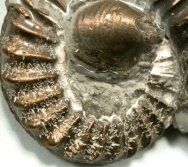Pleuroceras
spinatum with Brachiopoda Phylum
Mollusca, Class Cephalopoda, Subclass
Ammonoidea, Order Ammonitida, Family Pleuroceratidae
Geological
Time: Jurassic Lower Lias
Size (25.4
mm = 1 inch): Ammonite: 65 mm diameter Brachiopod; 20 mm across
Fossil Site:
Untersteurmig, Germany
 This
is an excellent example of ammonite beauty in Pleuroceras spinatum
of the Lower Lias (200 m.y.a) deposits of Germany. It more resembles
a bronze sculpture than the remnants of a living organism. It is
found with an attached Brachiopod, a shelled animal which looks
like the more familiar bivalves of today: the clams. The easiest
way to distinguish Brachiopods from Bivalves is in the symmetry
of the shells. The plane of symmetry in a Brachiopod shell passes
through the individual shell, while the Bivalvia have a plane of
symmetry that passes between the individual shells themselves. The
environment in which these were preserved was anoxic, leading to
formation of Iron Pyrite (Fool’s Gold). These are essentially
solid pyrite, with only the intricate suturing pattern that gave
strength to the shell for minimum weight highlighted in a delicate
white tracery. The ridge along the dorsal edge is the remnant of
the siphuncule, the means by which the ammonite “shifted ballast”
in order to rise and fall in the water column. This most artistic
specimen made all the more interesting by virtue of the association
with the Brachiopod. This
is an excellent example of ammonite beauty in Pleuroceras spinatum
of the Lower Lias (200 m.y.a) deposits of Germany. It more resembles
a bronze sculpture than the remnants of a living organism. It is
found with an attached Brachiopod, a shelled animal which looks
like the more familiar bivalves of today: the clams. The easiest
way to distinguish Brachiopods from Bivalves is in the symmetry
of the shells. The plane of symmetry in a Brachiopod shell passes
through the individual shell, while the Bivalvia have a plane of
symmetry that passes between the individual shells themselves. The
environment in which these were preserved was anoxic, leading to
formation of Iron Pyrite (Fool’s Gold). These are essentially
solid pyrite, with only the intricate suturing pattern that gave
strength to the shell for minimum weight highlighted in a delicate
white tracery. The ridge along the dorsal edge is the remnant of
the siphuncule, the means by which the ammonite “shifted ballast”
in order to rise and fall in the water column. This most artistic
specimen made all the more interesting by virtue of the association
with the Brachiopod.
See
more: Ammonite Fossils |
|




